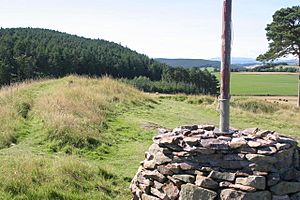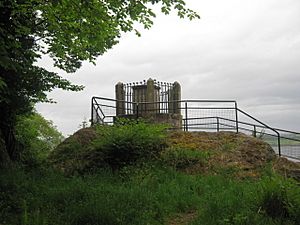Munro of Milntown facts for kids
The Munros of Milntown were an important family group within the larger Clan Munro in the Scottish Highlands. They were like a "junior" branch of the main Munro chiefs, but they were the very first one recorded. This made them very important, and many other smaller Munro family lines came from them. Sometimes, their name was spelled "Monro" instead of Munro. The Munros of Milntown are famous for being involved in many key events during the late Middle Ages in Scotland.
Contents
John Munro, First of Milntown
The Munros of Milntown came from Hugh Munro, 9th Baron of Foulis, who was a chief of Clan Munro and died in 1425. Hugh supported the Lord of the Isles at the Battle of Harlaw in 1411. John Munro was a younger son of Hugh and became the first of the Milntown family line.
John's older brother, George Munro of Foulis, was killed in the Battle of Bealach nam Broig in 1452. This meant that George's baby son, also named John Munro (who died in 1490), became the new chief. While the young John Munro of Foulis was still a baby, his uncle, John Munro of Milntown, became the "Tutor of Foulis." This meant he looked after the clan's affairs until the young chief grew up.
In 1454, John Munro of Milntown led the Clan Munro on a raid into Perthshire. As they were returning home, the Clan Mackintosh ambushed them at Clachnaharry. A fierce fight, known as the Battle of Clachnaharry, broke out, and many people from both sides were killed. It is said that John Munro of Milntown lost a hand, and the Chief of Clan Mackintosh was killed.
After the battle, John Munro, who was injured, was cared for by the Frasers of Lovat. This act of kindness helped create a strong friendship between the Fraser and Munro clans that lasted for a long time. John Munro, the first of Milntown, had two children:
- Andrew Mor Munro, who became the second of Milntown.
- John Munro, who became the first of Kilmorak.
Andrew Mor Munro, Second of Milntown
John Munro, the first of Milntown, was followed by his oldest son, Andrew Mor Munro, who became the second of Milntown. People described him as "a bold, strict, and brave gentleman, respected by his friends, and a terror to his enemies."
Milntown Castle
Andrew Mor Munro is believed to have built Milntown Castle around 1500. The castle was the family's home and was located at Miltown of Meddat. It was so close to Balnagown Castle that the chiefs of Clan Ross tried to stop the Munros from building it there. At this time, Sir Andrew Munro was also in charge of the royal Dingwall Castle. Andrew Mor Munro, the second of Milntown, was followed by his oldest son, Andrew Beg Munro, who became the third of Milntown and was also known as Black Andrew.
Andrew Munro, Third of Milntown
Perhaps the most famous person from the Milntown family line was Andrew Munro, the third of Milntown. He became known as Black Andrew of the seven castles. In 1512, he received a special document from the King for his lands. This document also gave him the important job of chief steward for the Earldom of Ross.
Also in 1512, King James IV of Scotland gave him a piece of land called the "markland of Tulloch." He had to pay a small amount of wax each year for it. Besides the lands of Milntown, Andrew bought and was given many other large properties in the county of Ross. These included Delny and Newmore, Contullich and Kildermorie, Dochcarty, Allan, and Culnauld.
He was called Black Andrew of the seven castles by local people because he had a castle on each of his seven estates. These included Milntown Castle, Contullich Castle, Delny Castle, and a tower house at Docharty. Andrew Munro, the third of Milntown, had three sons:
- George Munro, who became the fourth of Milntown.
- William Munro, who became the first of Allan.
- Andrew Munro, who became the first of Culnauld.
Black Andrew died in 1522, and his oldest son, George Munro, became the fourth of Milntown.
George Munro, Fourth of Milntown
In 1561, Queen Mary appointed George Munro, the fourth of Milntown, as the Bailie and Chamberlain for her lands and lordships of Ross and Ardmenach. This important job lasted as long as the Queen wished. Between 1561 and 1566, George Munro was also in charge of Tarlogie. In 1565, he held Inverness Castle for the King and Queen.
George Munro, the fourth of Milntown, added Newmore and Easter Aird to his lands. He also used Docharty near Dingwall, which he had inherited from his father, as a base. Because of this, he was sometimes known as George Munro of "Docharty." In 1561, George Munro was also made governor of the royal Dingwall Castle. Three of his younger brothers received the lands of Meikle Allan and Culnald. George Munro of Milntown was Mary, Queen of Scots's special officer for the royal lands of Ross and the Black Isle.
George Munro, the fourth of Milntown, had four sons:
- Andrew Munro, who became the fifth of Milntown.
- Donald Munro, who became the first of Tarlogie.
- George Munro, who became the first of Pitlunde. He was the Chancellor of Ross, and many other Munro family lines came from him, such as the Bearcrofts and Auchinbowie families. The Munro of Auchinbowie family is perhaps the most well-known of these.
- John Munro, who became the first of Pitonachy. Other Munro family lines also came from him, including the Novar and Findon families. A famous descendant was General Hector Munro, 8th of Novar.
George died in 1576, and his oldest son, Andrew Munro, became the fifth of Milntown.
Andrew Munro, Fifth of Milntown

In 1562, Alistair (Alexander) Gunn, the chief of Clan Gunn, offended the Earl of Moray. The Earl, with the help of Andrew Munro, the fifth of Milntown, trapped the Gunns near Nairn. The Gunn Chief was captured and taken to Inverness, where the Earl of Moray had him executed. The historian Sir Robert Gordon (1580–1650) wrote that Andrew Munro of Milntown set an ambush to capture Alexander Gunn. In 1568, Andrew Munro, the fifth of Milntown, also known as Andrew Munro of Newmore, acquired Ormond Castle and the lands of Suddie in Avoch.
Castle Chanonry of Ross
The Munros and the Mackenzies often had arguments and fights. Between 1569 and 1573, Andrew Munro, the fifth of Milntown, defended and held Chanonry of Ross Castle in the town of Fortrose on the Black Isle for three years. He had received the castle from Regent Moray, who died in 1569. Andrew defended it against the Clan Mackenzie, and many lives were lost on both sides.
The conflict ended when the castle was peacefully given to the Mackenzies under a peace treaty. In his books, Alexander Mackenzie claimed that the Munros tried to get fish from a nearby loch, but the Mackenzies stopped them and took control of the castle by force. However, Sir Robert Gordon (1580–1656) recorded that the castle was handed over through a peace agreement.
Sir Robert Gordon wrote about this conflict in his book A Genealogical History of the Earldom of Sutherland: The Munros defended and kept the Castle for the space of thrie yeirs, with great slaughter on either syd, vntill it was delyvered to the Clanchenzie, by the Act of Pacification. And this wes the ground beginning of the feud and hartburning, which to this day, remaynes between the Clanchenzie and Munrois.
Andrew Munro, the fifth of Milntown, had three sons:
- George Munro, who became the sixth of Milntown.
- Andrew Munro, who became the first of Kincraig.
- John Munro, who became the first of Fearn.
Munro also had five daughters. The youngest, Catherine, married a distant relative, George Munro, 1st of Obsdale. Andrew Munro, the fifth of Milntown, died in 1590, and his oldest son, George Munro, became the sixth of Milntown.
George Munro, Sixth of Milntown
The Munro of Milntown family grew so powerful that they began to rival their chiefs, the Munros of Foulis. In 1621, George Munro, the sixth of Milntown, became a Member of Parliament for Inverness-shire, which at that time included Ross, Sutherland, and Caithness.
George also added Meikle, Tarrel, and Ballone to his lands. He served in the Scottish Parliament between 1617 and 1621. George also built the tower and bell tower of the Church of Kilmuir-Easter. On top of the tower is an eagle, which is the symbol of the Munro family, and his initials "G.M."
George Munro, the sixth of Milntown, had three sons from his first marriage and two more sons from a second marriage:
- George Munro, who became the seventh of Milntown and took over his father's lands in 1623.
- John Munro, who fought in the Thirty Years' War under the clan chief, Robert Munro, 18th Baron of Foulis, and did not return.
- William Munro, who also fought in the Thirty Years' War under the clan chief and did not return.
- David Munro, who fought in the Thirty Years' War under the clan chief and did not return.
- Hector Munro, about whom there is no further information.
- John Munro, about whom there is no further information.
George Munro, Seventh of Milntown
When George Munro, the seventh of Milntown, inherited his father's lands, he also received the mills and the important job of chief steward of the Earldom of Ross. This included various payments, a piece of land called Markland of Tullich, and the lands and town of Meikle Meddat. George Munro, the seventh of Milntown, had two sons: Andrew Munro, who became the eighth of Milntown, and Hugh Munro.
Andrew Munro, Eighth of Milntown
Andrew Munro, the eighth of Milntown, was the last of his family to own the Milntown estate. However, Andrew was only eleven years old when his father died, so his mother's brother took control of the property and never actually let Andrew own it.
Andrew Munro served as a Captain under his relative, George Munro, 1st of Newmore, during the Irish Confederate Wars. While he was away, Milntown Castle accidentally burned down in 1642. In 1644, Andrew Munro, the eighth of Milntown, returned to Scotland. He played a brave part in the Battle of Kilsyth, where he was killed fighting at the front of his company. Andrew Munro was the last direct male descendant in the main line of the Munros of Milntown. The rights to Milntown Castle were sold in 1656 by Andrew's uncle, Sir John Innes, to George Mackenzie of Tarbat, who later became George Mackenzie, 1st Earl of Cromartie.
See also



